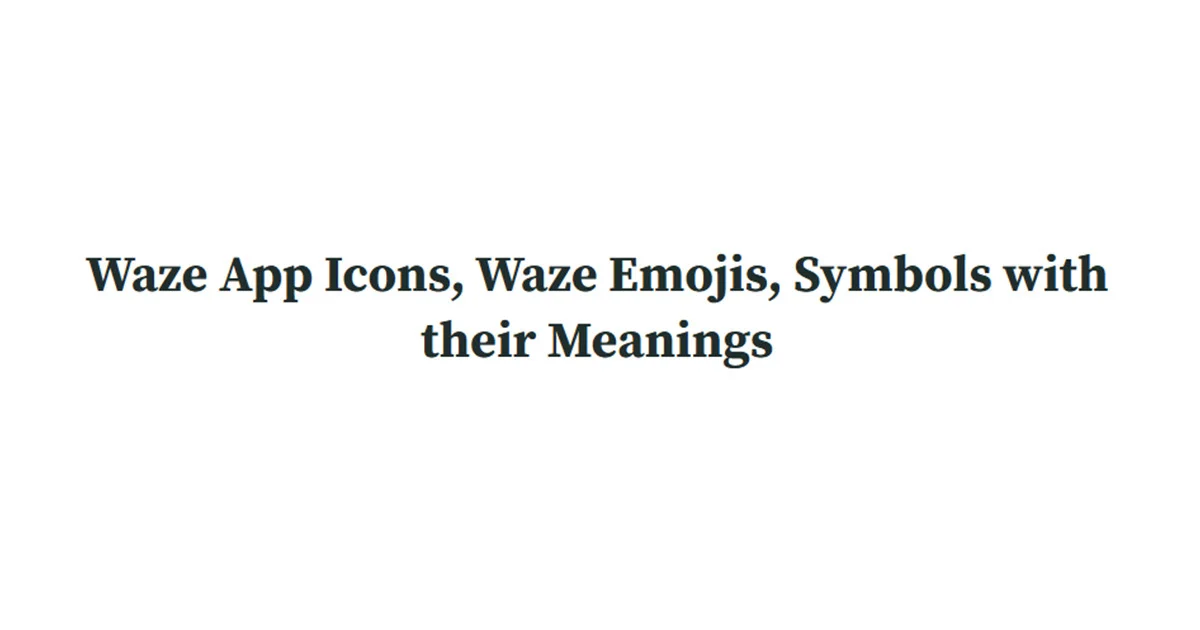Channel your inner Vogue and Confidence!

Driver distraction remains one of the leading causes of traffic accidents worldwide, with studies showing that visual distractions account for nearly 80% of all crashes and 65% of near-crashes. Presenting extensive information without drawing attention away from the road has become an important issue as navigation systems get more advanced. The solution is smart icon design that makes use of visual processing concepts and cognitive psychology to produce interfaces that drivers can quickly comprehend.
Comprehensive functionality and split-second comprehension must be balanced in modern navigation software. The speed at which drivers can receive visual information while keeping their primary concentration on driving is frequently what distinguishes safe interface design from unsafe interface design. This led to innovative icon design strategies that put recognition speed ahead of visual appeal.
Human visual processing works on numerous levels with pattern recognition occurring faster than comprehensive analysis. There are just milliseconds for drivers to comprehend information when they look at navigation screens before they have to turn back to the road. Effective navigation icons exploit this by using universally recognized symbols that trigger immediate cognitive responses.
Research in cognitive psychology shows that familiar shapes and symbols can be processed up to 60% faster than text-based information. This is why effective navigation applications avoid complicated images in favor of simple, high-contrast symbols that correspond to current mental models. A fork-and-knife emblem provides meal possibilities without the need for text interpretation and a gas pump sign conveys fuel availability more quickly than reading “Gas Station.”
The most effective navigation interfaces utilize what psychologists call “pre-attentive processing”—visual elements that the brain recognizes before conscious attention is applied. Colors, basic shapes, and movement patterns all trigger pre-attentive responses, allowing drivers to gather essential information without extended visual focus.
Color psychology plays a very important role in navigation safety with different hues triggering distinct emotional and cognitive responses. Red universally signals danger or urgency, making it perfect for accident alerts and traffic warnings. Green suggests safety and go-ahead actions, ideal for allowed turns and clear routes. Yellow communicates caution, appropriate for construction zones and potential hazards.
Modern navigation applications employ sophisticated color-coding systems that extend beyond simple alerts. Road classifications use distinct colors to help drivers quickly identify route types—purple for freeways, blue for major highways and white for local streets. This comprehensive visual symbol system allows drivers to understand their navigation context without reading detailed text descriptions.
The efficiency of color coding is also shown in traffic information, where color gradients are used to convey current circumstances. An easy-to-understand system that allows drivers to stay focused on the road is created by marking clear routes in green, moderate delays in yellow and heavy traffic in red.
The most successful navigation icons transcend cultural and linguistic barriers by using universally understood symbols. A camera symbol conveys speed cameras regardless of the driver’s native language. Police hat icons notify people of the presence of law enforcement without the need for language translation. In all cultural settings, work zones are indicated by construction cone symbols.
This all-encompassing method is especially helpful for tourists from other countries and in multilingual areas where text-based navigation might cause significant understanding delays. Regardless of literacy or language ability, symbols such as restaurant utensils, gasoline pump iconography and parking “P” indicators convey important information to all drivers.
The development of these universal symbols required extensive cross-cultural research to identify imagery that maintains consistent meaning across different societies. Navigation app designers study road signage conventions from multiple countries to create icons that feel familiar to the broadest possible user base.
Effective navigation icons must be visible and distinguishable under varying lighting conditions, from bright sunlight to nighttime driving. This requires careful attention to size, contrast ratios and visual hierarchy that ensures critical information remains clearly visible regardless of environmental factors.
High contrast design principles ensure that essential navigation elements stand out against map backgrounds. White text on dark backgrounds, bold icon outlines and sufficient spacing between elements all contribute to improved visibility and reduced eye strain during extended driving periods.
Visual hierarchy guides attention to the most critical information first. Turn directions are clearly shown, although other information, such as sites of interest, is still visible but in a secondary position. In addition to preventing information overload, this guarantees that drivers may obtain thorough navigation data when required.
Advanced navigation interfaces adapt their visual presentation based on driving conditions and user behavior. During high speed highway driving, interfaces simplify to show only essential information. In complex urban environments, additional detail appears to help with navigation decisions.
Context-aware design adjusts icon prominence based on relevance. Parking icons become more prominent as drivers approach their destinations, while fuel station alerts increase visibility when tanks run low. This dynamic approach ensures that the most relevant information receives appropriate visual emphasis without cluttering the interface.
It takes specific knowledge of both user experience design and vehicle safety regulations to create really safe navigation interfaces due to their complexity. In addition to visual design principles, professional interface designers also need to be aware of driver distraction regulations and automobile display regulations.
Navigation technology specialists such as those at WavyDestinations, provide crucial expertise in implementing interface designs that meet both usability and safety requirements. These experts make sure that navigation solutions improve rather than degrade road safety since they comprehend the delicate balance between overall functioning and driving safety.
For fleet management systems, commercial vehicle navigation and specialized transportation applications where interface design has a direct influence on operational safety and efficiency, expert assistance becomes especially beneficial.
Effective navigation icon design requires extensive real world testing to validate safety and usability claims. Eye tracking studies measure how quickly drivers can process different icon designs while driving simulators test interface effectiveness under various conditions.
A/B testing compares different icon approaches to identify designs that minimize distraction while maximizing information transfer. Heat map analysis reveals which interface elements attract attention and whether that attention aligns with intended navigation priorities.
This testing process often reveals counterintuitive results where aesthetically pleasing designs perform poorly in real driving conditions, while simpler, more utilitarian approaches prove safer and more effective.
The shift to autonomous cars fuels new developments in navigation interface design. While augmented reality overlays offer contextual information without necessitating focus shifts to separate devices, voice activated controls lessen visual distraction.
Artificial intelligence increasingly personalizes navigation interfaces, learning individual driver patterns and adjusting information presentation accordingly. Some drivers prefer minimal interfaces while others benefit from comprehensive data displays—AI customization accommodates these preferences while maintaining safety standards.
Visual safety in navigation represents a critical intersection of cognitive psychology, interface design and automotive safety. As vehicles become more connected and navigation systems more sophisticated, the importance of distraction preventing design continues to grow.
The best navigation interfaces combine universal symbols, smart color coding and adaptable information display to keep drivers securely focused on the road, prioritizing instant comprehension over intricate functioning. Understanding human cognitive limits as well as the demanding environment of vehicle driving is necessary for success in this subject.
The future of navigation safety lies in continued research into human computer interaction, combined with practical testing that validates theoretical design principles in real world driving conditions.

The Fashion and Style enthusiast with a flair for drama and entertainment! A millennial on the lookout for the trending styles inspired by and believes in: “You can get anything in life if you have the right dress for it!” Adding a little magic through the power of words and not holding back on fashion and styling opinions! Let’s connect to stay on top of trend alerts and the who is who of Fashion world and get inspired to give your personality the styling oomph you’ve been craving for! Nageen Abbas at Vogue Vocal is the brains behind our Woke Vogue and Lifestyle Library!